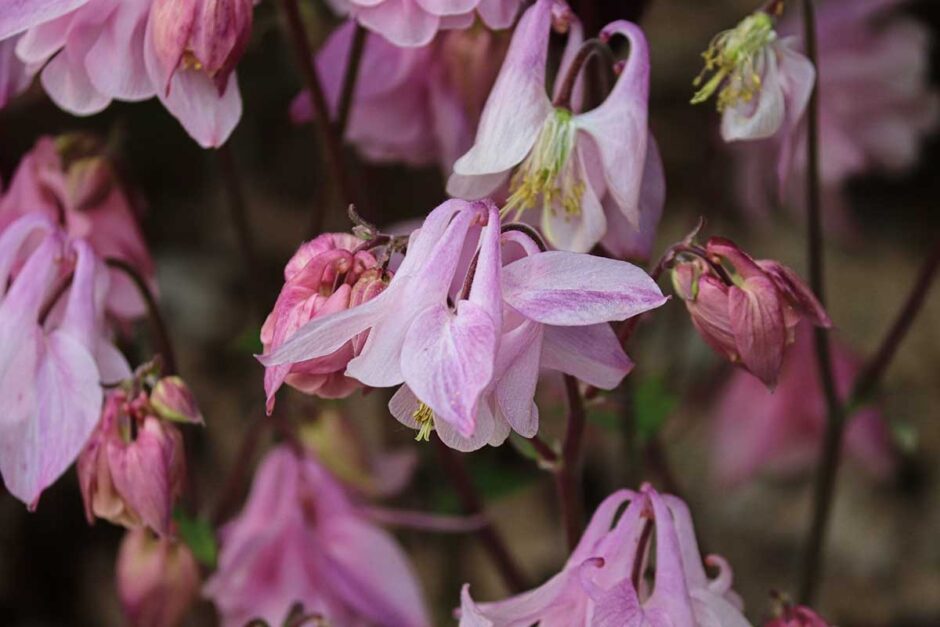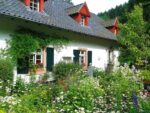
It can be a challenge to find the right plants for shade or areas with little direct sunlight, such as north-facing gardens. Personally, I believe it is important to make the most of any garden and value every square inch.
Every garden will have areas where most plants will not grow. These will often be places with partial or total shade. However, nature always finds a way to populate every nook and cranny with flora and fauna.
To underscore this, I’ve compiled the following list of “Plants for Shade & North-Facing Gardens”. You might want to experiment with many of these plants within your own shaded garden.
Plants for shady Areas & north facing gardens
Here is a list of shade-loving plants to think about for that awkward spot in the garden. What you can grow in partial to full shade will amaze you.
- Acer – Delicate tree.
- Aconitum – Tall, woodland flower. Very poisonous.
- Actaea simplex – Shade-loving plant, with fluffy ‘feather duster-like flowers.
- Anemone Jobert – The Japanese anemone is a very reliable flowering plant.
- Astilbe – Feathery flowers come in shades of pink, red, or white. Loves damp ground.
- Astrantia – Clump-forming shade-loving plant, best grown for its attractive leaves.
- Balloon Flower – A showy member of the bellflower family.
- Baptisia – Also known as ‘Wild Indigo’. A lupin/pea-like flower. Prefers dry, shady spots in the garden.
- Begonia – Most varieties thrive in low light. Looks great in hanging baskets, tubs and pots.
- Bell Flower (Campanula carpatica) – A clump-forming perennial with bright blue, white, pink or purple bell-shaped flowers.
- Bergenia – A great plant for shade. Glossy leaves turn red in the autumn.
- Bishop’s Hat (Epimedium grandiflorum) – An elegant, deciduous plant, with attractive, heart-shaped foliage.
- Brunnera macrophylla – A larger leaved version of forget-me-nots.
- Busy Lizzie (Impatiens walleriana) – A colourfully flowered and prolific garden annual.
- Camellia – A rose-like shrub, with glossy leaves. Prefers acid soil.
- Cardinal Flower – A day-glow red tri-petal flower on spikes, above dark red foliage. Part of the Lobelia family.
- Celandine poppy (Stylophorum diphyllum) -With bright yellow flowers.
- Coleus (Solenostemon scutellarioides) – A perennial with a wide variety of colourful, patterned leaves. Perfect in pots. Bring Coleus indoors during the Winter.
- Coralbell, Alumroot (Heuchera) – Attractive foliage. A great plant for a woodland garden.
- Cornus Alba Sibirica – A deciduous shrub with slender red stems, which become bright crimson during winter.
- Crinum Powellii – A lily-like perennial bulb-based plant. With large, pink flowers above a canopy of green, grass-like leaves.
- Daylily (Hemerocallis) – Bright orange/red lily-like flowers with grassy leaves. The flowers are edible. A recommended addition to a shady spot in the garden.
- Dryopteris filix-mas – A common fern. Will tolerate deep shade.
- Euonymus Albovariegata – glossy evergreen shrub with green or variegated leaves.
- Foam flower (Tiarella) – Clump-forming herbaceous perennial with a spike of pink flowers.
- Foxglove – A common flowering plant, found in most woodlands in the UK.
- Fuchsia, Bleeding Heart – Interesting heart-shaped, red and white flowers hang from curving stems.
- Garden Phlox – Long-blooming, colourful flowers. Some varieties are scented.
- Geraniums – A flowering perennial plant. Can cope with plenty of abuse. Not to be confused with indoor Geraniums, which are ‘Pelargoniums’.
- Globe Thistle (Echinops) – Spiny, thistle-like foliage and blue or white spherical flower heads.
- Goat’s Beard (Aruncus dioicus) – An attractive perennial, shade-lovely plant with feathery plumes of tiny, white/cream flowers.
- Impatiens namchabarwensis – A 50 cm tall plant, with blue flowers.
- Japanese Painted Fern (Athyrium nipponicum) – A fern with lance-shaped leaves, with a variegated appearance.
- Lady’s Mantle (Alchemilla mollis) – A lower-growing woodland plant with scalloped leaves and frothy yellow/green flowers.
- Leopard’s Bane (Doronicum orientale) – Bright yellow, daisy-like flowers.
- Ligularia – An elegant flowering plant with yellow or orange sunflower-like heads with brown or yellow centres.
- Lily of the valley (Convallaria majalis) – White, highly scented snowdrop-like flowers, above spear-shaped leaves. Poisonous.
- Peony – Rose-like flowers with large, glossy leaves.
- Primrose – Cabbage-like leaves and brightly coloured buttercup-like flowers. The flowers are nice if added to salads.
- Ranunculus – Showy, rose-like flowers. A close relative of the buttercup.
- Redwood sorrel (Oxalis oregana) – A low-growing perennial with clover-shaped leaves, with delicate white or pink flowers. Perfect for a north-facing garden.
- Rhododendron – A fast-growing shrub, with exotic pink, red or white flowers. Very shade-hardy. Prefers acid soil.
- Solomon’s seal (Polygonatum humile) – arching, fern-like stems, with small white hanging flowers. A lovely woodland plant for shade.
- Spurge (Euphorbia cyparissias) – A robust, architectural plant, with green/yellow flowers.
- Strawberry geranium (Saxifraga stolonifera) – A spreading woodland perennial, with attractive and hairy leaves.
- Toad lily (Tricyrtis) – A shade-loving, tri-petalled, and spotty flowering plant.
- Trillium grandiflorum (Wood lily) – A graceful, lemon-scented plant, with white, tri-petalled flowers.
- Veronica, Speedwell – A perennial with long spikes of purple, blue, pink, or white flowers. Very shade-loving and easy to grow.
- Viburnum – A shrub with highly scented flowers.
- Viola – Similar to the Pansy, but with smaller flowers. Grows well in shade.
- Woodrush (Luzula sylvatica) – a grassy, shade-friendly plant, with large, glossy leaves.
- Yarrow – Yarrow is typically a meadow plant, but can also do well in shade.
Plants for full shade – Woodland Plants
And now for a list of the toughest of the tough; plants that can grow in the shadiest spots in the garden:
- Amsonia – With lance-shaped leaves and small, starry blue flowers.
- Asters – A classic daisy-like perennial flower. Often blue, white, pink or purple petals with bright yellow centres.
- Aucuba – A variegated laurel. Very easy to grow shrubs for a shady garden.
- Bamboo Pleioblastus Variegata – An evergreen bamboo. Perfectly suited for a shady, north-facing garden.
- Box (Buxus) – A privet-like shrub. The perfect hedging plant for a shady garden. Its thick branches with tiny leaves can be sculptured into a wide variety of shapes.
- Columbine (Aquilegia) – A fairy-tale-like woodland flowering plant.
- Cyclamen – A small, perennial woodland classic, with pink, white, or red flame-like flowers above fractal-decorated, heart-shaped leaves. Perfect for growing around the shady roots of trees. My favourite plant for shade.
- Daphne laureola – A highly scented shrub for a woodland garden. Poisonous.
- Helleborus – Hellebores flower during Christmas. A lovely woodland plant with large pink, white, purple or spotted flowers and dark glossy leaves.
- Hosta – Adds a touch of the tropics to a shady garden. Lovely, fresh leaves in a wide variety of colours.
- Ivy – The very best plant for deep shade. Will even grow in near darkness!
- Lungwort (Pulmonaria) – A semi-evergreen, spring-flowering shade-loving plant with blue, pink or red hanging flowers.
- Skimmia – A dark, glossy leaved shrub, with scented yellow, pink or red flowers. Makes a very good plant for shade.
If you are looking for the ultimate plants for shade, I’d recommend Hydrangea anomala petiolaris (Climbing Hydrangea). This tough, shading-loving climber will happily scramble up a dark north-facing garden wall and cover it with lovely green leaves and white flowers.
Which are the best plants for shade
Climbing Hydrangea, Ivy, Cyclamen, Hosta, Helleborus and Skimmia are great plants for shade.
Is it easy to establish a garden in the woods?
A great many plants prefer partial or even full shade. It is just a questions of selecting the right kind of plants that will thrive and look great in a woodland setting.



